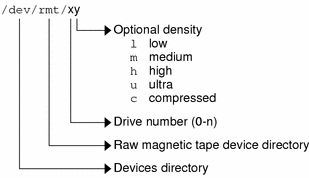Specifying the Slice
The string you use to identify a specific slice on a specific disk depends on the controller type, either direct or bus-oriented. The following table describes the different types of direct or bus-oriented controllers on different platforms.
Table 29-2 Controller Types
Direct controllers | Bus-Oriented Controllers |
|---|---|
IDE (IA) | SCSI (SPARC/IA) |
| ATA (SPARC/IA) |
The conventions for both types of controllers are explained in the following subsections.
Note - Controller numbers are assigned automatically at system initialization. The numbers are strictly logical and imply no direct mapping to physical controllers.
SPARC: Disks With Direct Controllers
To specify a slice on a disk with a direct controller on a SPARC based system, follow the naming convention shown in the following figure.
Figure 29-2 SPARC: Disks With Direct Controllers

To indicate the whole disk, specify slice 2 (2).
If you have only one controller on your system, x is usually 0.
IA: Disks With Direct Controllers
To specify a slice on a disk with an IDE controller on an IA based system, follow the naming convention shown in the following figure.
Figure 29-3 IA: Disks with Direct Controllers

To indicate the entire Solaris fdisk partition, specify slice 2 (s2).
If you have only one controller on your system, w is usually 0.
SPARC: Disks With Bus-Oriented Controllers
To specify a slice on a disk with a bus-oriented controller (SCSI, for instance) on a SPARC based system, follow the naming convention shown in the following figure.
Figure 29-4 SPARC: Disks With Bus-Oriented Controllers

If you have only one controller on your system, w is usually 0.
For SCSI controllers, x is the target address set by the switch on the back of the unit, and y is the logical unit number (LUN) of the drive attached to the target. If the disk has an embedded controller, y is usually 0.
To indicate the whole disk, specify slice 2 (s2).
IA: Disks With SCSI Controllers
To specify a slice on a disk with a SCSI controller on an IA based system, follow the naming convention shown in the following figure.
Figure 29-5 IA: Disks with SCSI Controllers

If you have only one controller on your system, v is usually 0.
For SCSI controllers, w is the target address set by the switch on the back of the unit, and x is the logical unit number (LUN) of the drive attached to the target. If the disk has an embedded controller, x is usually 0.
To indicate the entire Solaris fdisk partition, specify slice 2 (s2).
Logical Tape Device Names
Logical tape device files are found in the /dev/rmt/* directory as symbolic links from the /devices directory.
Figure 29-6 Logical Tape Device Names

The first tape device connected to the system is 0 (/dev/rmt/0). Tape density values (l, m, h, c, and u) are described in Chapter 51, Managing Tape Drives (Tasks).
Logical Removable Media Device Names
Since removable media is managed by volume management (vold), the logical device name is usually not used unless you want to mount the media manually.
The logical device name that represents the removable media devices on a system are described in Chapter 18, Accessing Removable Media (Tasks).




